BadwaterJournal.com
WHAT UNSUSTAINABLE URBAN GROWTH LOOKS LIKE
Published online at Louisville, Kentucky USA -
An independent, secular, contemporary journal of political and environmental issues dedicated to peaceful reduction of human impacts on Earth

MSD’s $ 850 Million CSO Overflow Basin Plans ignore flood of rain water from parking lots
A large concrete sewer overflow basin will be constructed by MSD contractors at the old Public Works property at Logan and Breckinridge Streets next to the concrete channel of the South Fork of Beargrass Creek. Integral to the basin construction is a separate, $ 29.4 million dollar contract to install a large capacity sewer interceptor pipe running from west of the Medical Center at Poplar Level and Eastern Parkway along the concrete creek channel to the CSO Basin.
According to the 2012 Integrated Overflow Abatement Plan Update, the Logan Street CSO Basin was “upsized” between its 2009 projected size of 11.83 million gallons of overflow storage to the 2012 projected size of 16.6 million gallons. The price jumped from
$ 30.3 million dollars in 2009 to $ 52.2 million in 2012. Much of the millions of gallons of overflows to be captured by the CSO basin could be avoided by requiring green infrastructure on major parking lots.
Mid-city Mall and CSO overflow HERE
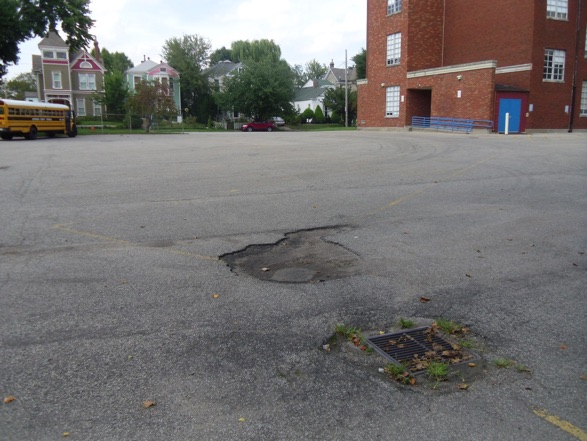
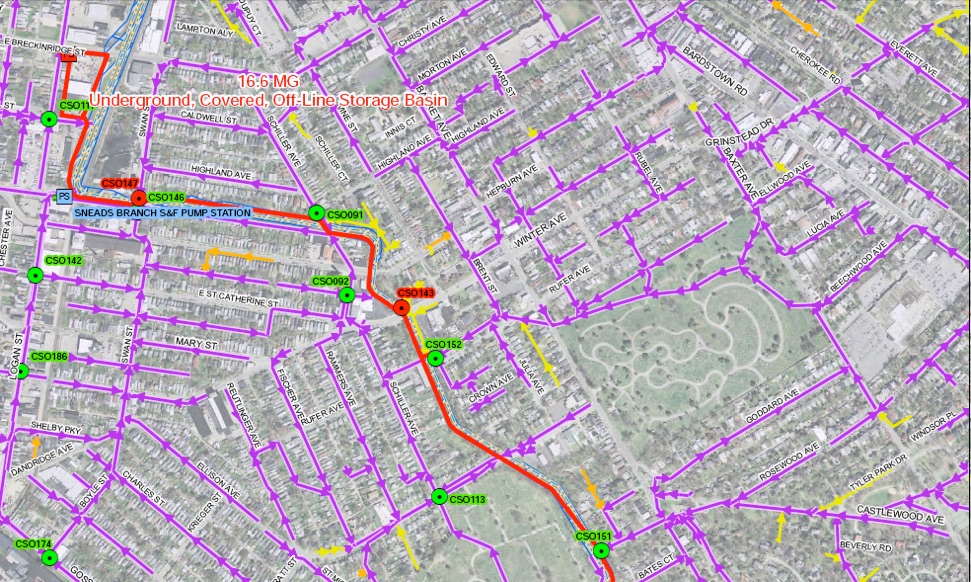
Mid-city Mall multi acre parking lot drains to CSO 152
Traditional JCPS School parking lot at Morton and Edward St. Here, an area drain dumps rainwater into the combined sewers. 1 acre-inch = 27,154 gallons that could be absorbed by bio-retention rain gardens that reduce heat island effect.
The combined cost of the $ 52.2 million Logan Street Basin and the new interceptor, according to the 2012 data produced by MSD and the recent contract No. 350,941 awarded to Garney Companies Inc. for $ 29,431,087 amounts to about $ 81.6 million dollars.
This enormous expense of high maintenance concrete basins and automated CSO diversion and relief gates opens MSD to questions of cost inflation and corruption. Most glaring is the fact that MSD has not proposed comparatively low cost green infrastructure projects to remove and divert rainwater from getting into the sewer system in the first place in the Logan Basin system.
I walked the area recently and photographed many parking lots and road area drains that could be removed from the sewer system reducing the size of the overflow basin. MSD should present the potential basin reduction possible in a cost comparison where green infrastructure is implemented.
MSD has complained that Metro Council has not granted it the authority to compel large parking lot owners -by ordinance- to install rain barrels, rain gardens or other rain harvesting measures on private property.
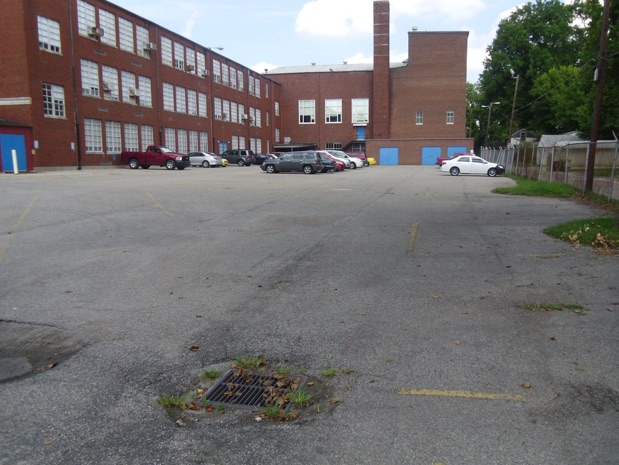

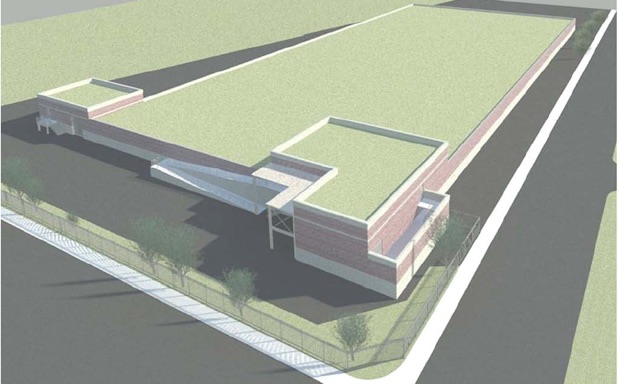
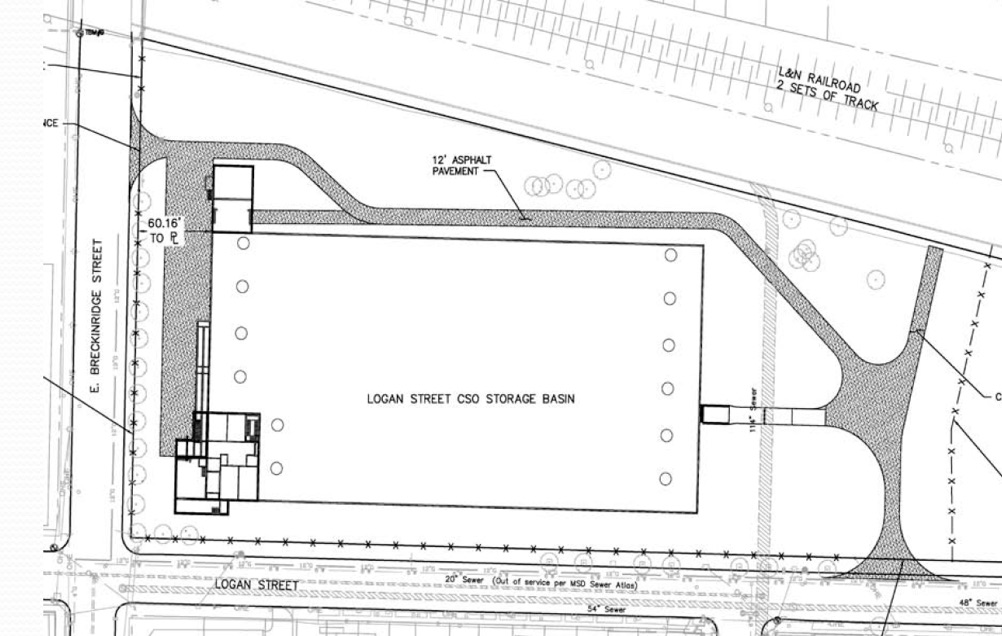


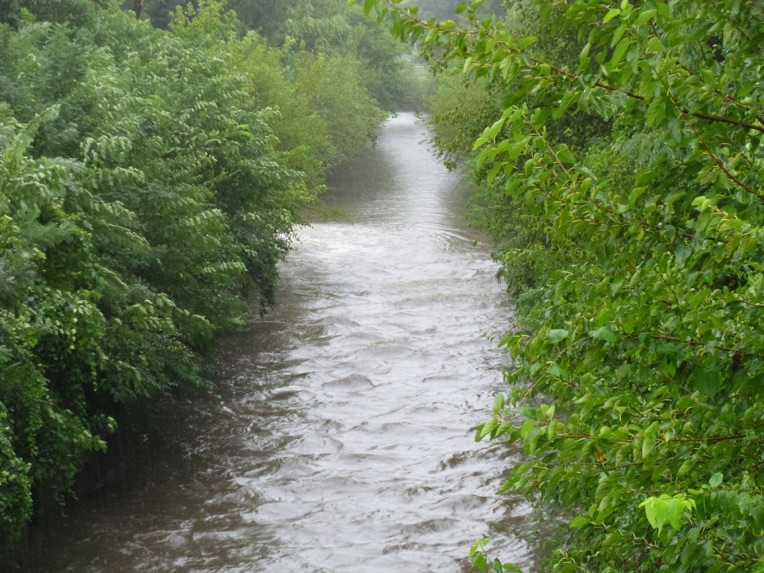

Much of the information for this article comes from MSD’s webpage HERE
Scientists calculate annual tire wear particulate in Japan would fill Tokyo Dome stadium
A well researched open access article distributed under the Creative Commons Attribution License, is available online and concludes:
“The annual volume of dust resulting from tire wear, calculated based on the number of automobiles registered in Japan, was 1,747,245.4 m3.[cubic meters] To put it simply, this translates to approximately 1.4 times the volume of the Tokyo Dome, a famous Japanese baseball stadium. Particulate substances are categorized into three groups depending on their size, and dust resulting from tire wear is classified into the coarse particle mode along with mold spores, pollen, and dust produced from brake pads. This study examined whether or not tire dust causes health damage similarly to pollen, a particulate substance in the same group. There were 38/cm2 dust particles resulting from tire wear on a busy road in Osaka Prefecture, and this number was larger than that of cedar pollen/cm2 (35), a cause of hay fever, identified in Hokkaido. The results suggest that tire dust may also adversely affect the health of people if any of its constituents has a toxicity or causes allergies.
See, Masakazu Yamashita, Shohei Yamanaka,
Dust Resulting from Tire Wear and the Risk of Health Hazards, Journal of Environmental Protection, 2013, 4, 509-515 http://dx.doi.org/10.4236/jep.2013.46059 Published Online June 2013 (http://www.scirp.org/journal/jep)
BadwaterJournal previously estimated that:
“Every year, the abrasion of motor vehicle tires from some 280 million to 290 million U.S. vehicle tires, releases 4 times the Deepwater Horizon spill volume in TWP (tire wear particulate) composed of zinc, latex rubber, carbon black, polyaromatic hydrocarbons and other constituents. This volume is equivalent to 4 ultra supertanker capacities of tire rubber particulate spilled into the U.S. environment every year.” See related webpage ‘Tire Story‘ HERE

“A common respiratory disorder caused by dust is pneumoconiosis. It is usually caused by inhaling dust from soil, metal particles, and other inorganic substances, or mineral dust while working over a long period of time. These dust and fine particles accumulate in the lung, serving as nuclei, and cause fibroplasia and pulmonary fibrosis.
In patients with pneumoconiosis, fibrous tissues are formed and the tissues of the alveoli, bronchioles, and blood vessels are destroyed. Patients develop dyspnea, and become vulnerable to pulmonary tuberculosis, secondary bronchitis, and other complications. Agents responsible for causing pneumoconiosis and occupations associated with it are listed in Table 5 [13]. Talc, black lead, and carbon, shown in Table 5, have been reported to cause pneumoconiosis in the process of producing raw materials of tires. As professionals work, these sub- stances accumulate in their bodies little by little every day, and they eventually amount to an enormous volume. In general, the volume of accumulated tire dust is not large enough to cause pneumoconiosis, although the concentration of tire dust contained in the air above heavy traffic roads may be high enough to cause chronic bronchitis and bronchial asthma.
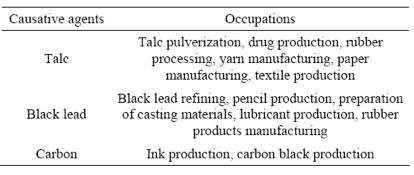
VEHICLE COMBUSTION
EPA “Report on Environment” is a cover-up of failed regulation of
ultra-fine particulate pollution
EMAIL TO EPA
Stephanie Sanzone, EPA Re:
EPA's Report on the Environment (ROE) 2014:
Please communicate my comments to the appropriate committee members.
COMMENT:
I object to the present form and content of the ROE Particulate Matter Emissions chapter. EPA is producing a misleading report that misinforms Congress and will result in failure to properly assess the public health dimensions of ultrafine particulate anthropogenic emissions, leading to policy failure to regulate same.
REQUEST: Update and rewrite the Particulate Emissions Chapter to explain the failure of gravimetric method air quality monitoring to detect the major health threat of UFP.
Describe the necessary changes in monitoring methods--particulate counts--to detect concentrations of UFP in urban traffic corridors. Describe the penetration of UFP deeper into lungs and crossing blood cell barrier and nervous system. Describe the changes to automobile combustion engineering to make smaller particulate to avoid NAAQS violations from PM2.5 or PM10 mass concentrations.
Describe EPA complicity with transportation industry in delaying effective monitoring despite a decade of peer reviewed research on the threat of UFP.
ARTICLES INCLUDED: Ultrafine Particles on and near Roadways: Exposure Assessment and Mechanism Yifang Zhu , Ph.D. Environmental Health Sciences Department Fielding School of Public Health University of California Los Angeles
[available for download online--Google search the title]
Impact of Vehicle Development and Fuel Quality on Exhaust Nanoparticle Emissions of Traffic Huan Liu, Topi Rönkkö,and Jorma Keskinen
Environ. Sci. Technol. 2013, 47, 8091−8092
EPA is revising its 2014 Report on the Environment--a foot dragging exercise if there ever was one. I sent the letter shown at right. EPA has been aware for a decade that the mass gravimetric NAAQS protocols that are the basis of MOVES and MOBIL emission factors do not account for heavy urban concentrations of ultra-fine particulates. Many peer reviewed journal articles and EPA public funded studies demonstrate that severe health impacts are affecting millions of citizens because EPA’s NAAQS monitoring excludes ultrafine particulate number concentrations. The consensus of peer reviewed is that UFP penetrate deeper in the lungs, blood and nervous system than coarse particulates which are reported under NAAQS.
"The exhaust of modern vehicles contain nanoparticles. They differ from soot particles by their size, being typically smaller than 30 nm in diameter, by formation process, and by physical and chemical characteristics. Consequently, the effect of technical abatement methods on them is different. Due to the small particle size and the formation process, where most of the particle mass is formed during exhaust cooling process in the atmosphere, the present
emission regulations do not take into account these particles.
However, several urban air studies conducted in the vicinity of traffic, report ambient air particle number
size distributions dominated by nanoparticles."
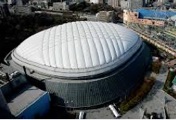
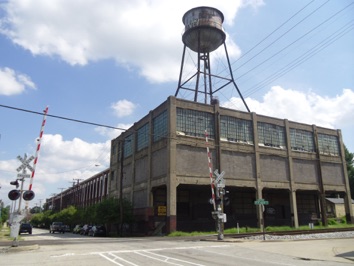
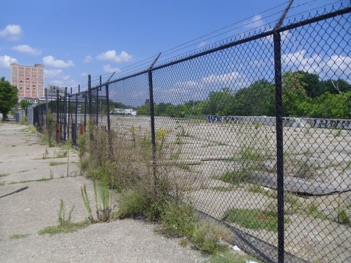
The MSD concept drawing of the Logan Basin at left. Buildings in the area have roof leaders disappearing into the collection system. The chain link fenced basin location just above.
The CSO basin will have a pump station that lifts the sewer overflow volume out of the creek channel and then gravity flows the sewage back in dry weather through sewer interceptor pipes all the way to the treatment plant on Algonquin Street in the west Louisville area. The circles on the drawing below appear to represent ventilation ducts.

“What does raceism have to do with it?”
‘Is Healing Possible Quorum‘ needs to ask the right questions







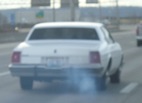


Heavy rain on 7-19-2012 at the
Mid City Mall parking lot on
Baxter Avenue
SOUTH FORK
CONCRETE CHANNEL
CSO 152 in dry weather
Parking lot runoff from Mid City Mall flows into street catch basins on Baxter Avenue and into the combined sewer system feeding CSO 152 shown below overflowing
The public rate payers are at the mercy of the MSD Board and the Metro Council representatives. In carrying out their tasks these appointed and elected officials frequently have too little grasp of sewer system hydraulics, and too little desire to challenge engineering decisions that push forward multi-million dollar pork barrel projects. MSD’s engineering team has a checkered record because it enabled the ravenous developers to create a sprawl urban development system that overloaded and outpaced sewer development. To prevent a citizen lawsuit that would impose effective controls --MSD, KYDOW and the EPA entered into a Consent Decree to halt the most egregious Clean Water Act violations and force sewer infrastructure planning even as sprawl continued.
The same big money motives propel an Integrated Overflow Abatement Plan that puts the cart before the horse--proposing enormously expensive basins before any green infrastructure project basin reductions that could be achieved under a GI ordinance.
The general rate payers will be charged some $ 3.3 billion dollars of capital and interest to pay for the IOAP and Metro Government has not asked how that amount could be reduced by passing a general green infrastructure ordinance.
In the meantime, large parking lots made of asphalt continue to cause heat island problems. Though MSD has several green infrastructure projects in progress--more need to be planned.
See the related webpages
AREA DRAINS HERE
and IOAP Two HERE
The MSD engineering team is proposing projects that do not disturb the status quo in a time when innovative design is critical.
Green infrastructure projects address heat island impacts, tree canopy loss and ever more expensive sewer rates. Our local government and its agencies have tapped the public purse too deeply for too long.
MSD’s EPA Rain Catcher award for CSO 130 elimination is not as effective as a Metro green infrastructure ordinance
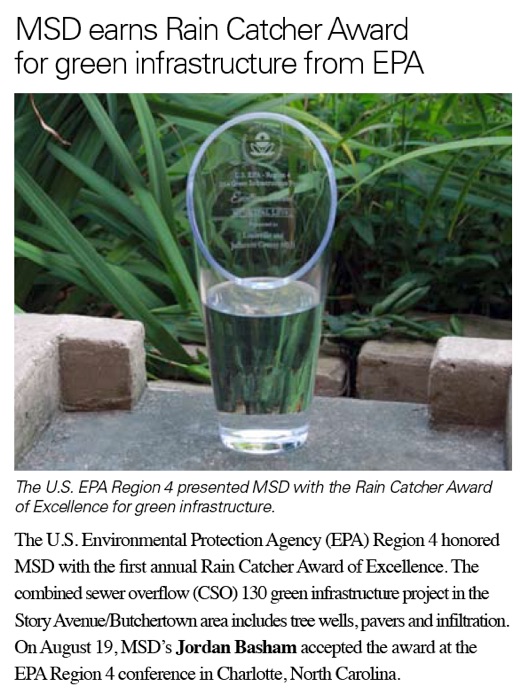
The September issue of MSD’s public relations newsletter, STREAMLINE is available for download from MSD’s webpage. The newsletter contains an article trumpeting MSD’s award from Region 4 EPA of a “Rain Catcher’ trophy. This was awarded for the CSO 130 combined sewer overflow ‘elimination’ project that will remove stormwater from the sewer system and stop sewer overflows to Beargrass Creek behind Story Avenue in Butchertown. The use of green infrastructure to reduce storm water inflow is laudable and the CSO 130 elimination model should be expanded to more GI projects throughout the MSD system. In fact, MSD is considering and working on more GI projects to reduce or possibly eliminate the 15.13 million gallon basin proposed at I-64 and Grinstead.
In addition to destroying existing wetlands habitat behind Jim Porter’s, the construction of the huge basin (footprint shown in red line below) would also involve significant tree removal corridors along the creek and both sides of the expressway to install large capacity sewer lines shown in red.
MSD has a number of good projects under way like the storm sewer separation project for CSO 140. In conjunction with green infrastructure, sewer separation projects can remove millions of gallons of storm inflow and reduce or eliminate giant concrete basins. MSD has estimated that 60 million gallons of green infrastructure removal projects would eliminate the 15.13 million gallon Grinstead Basin. Sewer separation could be used on CSO 126. MSD has also moved forward with partners in the CSO 166 sewershed, like Baptist Seminary, to identify 48 million gallons of GI projects to be installed. This is great news from MSD, and appears to leave 12 million gallons of GI to go to eliminate the Grinstead Basin. Metro Council could help by passing a phased-in comprehensive ordinance mandating adoption of GI projects on private parking lots and major commercial ‘big box’ stores and factories.

Footprint of the 15.13 million gallon basin at I-64 and Grinstead from the MSD 2012 IOAP Projects Update.
MSD’s Chief Engineer insists I-64 Basin will not be eliminated by green infrastructure projects
I previously estimated that MSD could find 12 million gallons of annual overflow removal in the I-64 CSO overflow basin catchment and thereby reach a total of 60 million gallons of stormwater inflow reductions by green infrastructure projects and eliminate the I-64 Basin.
In 2012 MSD proposed to build a 15.13 Million gallon concrete storage basin costing some $ 49 million behind Jim Porters. They will have to fill wetlands and mow down a substantial forested area to do it, and odor problems from settled sewage will have to be controlled. Evidently MSD does not intend to eliminate the basin with more green infrastructure projects and will instead pump contaminated stormwater to Morris Forman for treatment.
MSD Chief Engineer Steve Emly reponded:
All,
MSD is obviously not able to keep up with all that is written or said about what we do here for our community. We also recognize that there are those in the community who do not/will not agree with every decision we make and direction we take; we respect those opinions and the right to express them openly.
Communication and engagement with our customers, whether positive or negative in nature, allow us to continue to improve our performance and better serve the community.
Occasionally we see articles written or information otherwise disseminated from various sources about our work that we feel require some sort of a response, either because our positions are being misrepresented or our data is being misconstrued; this is one of those cases. We respect Mr. Hixons' passion for his work, and we engage with him frequently on various levels; sometimes we agree with his positions and sometime we don't. The article below, written by Mr. Hixon and distributed to elected officials and media (cc'd here), indicates that MSD may be "near to eliminating" the need for the I-64/Grinstead CSO Basin. This is absolutely not the case, and I consider it irresponsible to report otherwise based on what he has surmised through an Open Records Request. Mr. Hixon is not employed by MSD, and while we respect his opinions and his right to express them, we would prefer that he not attempt to speak on our behalf.
MSD is a nationally recognized leader in green infrastructure, having willingly included over $47 million in green infrastructure initiatives years ago as part of our original Consent Decree.
Through much research, engagement with other communities, construction of green practices and monitoring of those practices, we are becoming much more aware of the long term advantages and disadvantages of different practices, and how those practices perform throughout different regions of our service area. We clearly share Mr. Hixons enthusiasm for green infrastructure.
We have listened and responded to feedback from some who claim that storm water capture/diversion/infiltration should be used exclusively to control the problems associated with CSO's in our community; this solution is not viable in many cases and for many reasons which we won't debate here. We have stated publicly, on every occasion that we could, that while we will consider other options, there would likely remain the need for a storage facility near I-64/Grinstead Drive; and in fact there is.
We do have good news to report on the 16th, but it does not involve the complete elimination of the need for a CSO basin at this location. Hope to see you then.
Respectfully,
Steve W. Emly, PE
Chief Engineer